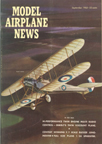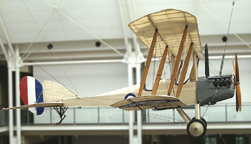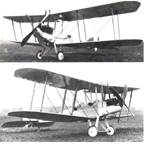September, 1963

Royal Aircraft Factory BE.2 "Quirk"
Model Airplane News Cover Art for September, 1963
by Jo Kotula
Click to Enlarge
The Royal Aircraft Factory B.E.2 (B.E. = Blériot Experimental) was a British single-engine two-seat biplane in service with the Royal Flying Corps (RFC) during World War I. About 3,500 were built, used as fighters, interceptors, light bombers, trainers and reconnaissance aircraft. It was designed by Geoffrey de Havilland and first flew in February 1912. It was first produced as a reconnaissance machine and was sent to France shortly after the outbreak of war. The early B.E.2a and b aircraft were replaced during 1915 by the B.E.2c, so extensively modified as to be virtually a new type.. The "c" began to be superseded by the final version, the B.E.2e, nicknamed the "Quirk", in 1916. The last front-line B.E.2e was withdrawn in 1917, long after the type was obsolete. It continued in service throughout the war as a home defence fighter and as a trainer. Some 3,500 B.E.2s were built by over 20 different manufacturers.


Royal Aircraft Factory BE.2 "Quirk"
Click to Enlarge
The B.E.9 and the B.E.12 were variants designed to give the B.E.2 an effective forward-firing armament - the B.E.12 (a single seater) went into production and squadron service, but was not a great success.
Although the B.E.2 had a reasonable performance for 1914/15 it remained in service long after much more powerful aircraft had become available to the enemy. Its small air-cooled inline motor made it seriously underpowered, and was unreliable even by the standards of the time. When bombs were to be carried, the observer and his gun had to be left behind. The vast array of wires and struts made it difficult for the gunner to get a clear shot. The essential vulnerability of the B.E.2 became plain in late 1915, with the advent of the first German fighters. This led the British press to dub it "Fokker Fodder", while German pilots nicknamed it kaltes Fleisch (Ger.: "cold meat"). British ace Albert Ball summed it up as "a bloody awful aeroplane". An incident the level of popularity of the B.E.2e on the Western Front is recorded by Arthur Gould Lee, then a young RFC novice, in his book No Parachute. On 19 May 1917 six pilots newly arrived in France and, still to be allocated to a squadron, were each given a new B.E.2e to ferry between RFC depots at St Omer and Candas. One crashed in transit, three crashed on landing and one went missing (the pilot was killed). Lee, the pilot of the only aircraft to arrive safely, wrote in a letter to his wife:
"...I felt rather a cad not crashing too because everyone is glad to see death-traps like 'Quirks' written off, especially new ones..."
Here is a video of the Royal Aircraft Factory BE.2 "Quirk" in action:
Click Here for more information about the Royal Aircraft Factory BE.2 "Quirk".

Click to go back and select another cover.
Counter for the Entire Site (not just this page..)
Home | About Lindy | Last Week's Reviews | Upcoming Events | 1940s Collecibles
The Guide - Establishments - Travel - Accessories
Music | Links | Photo Gallery | Extras | Contact